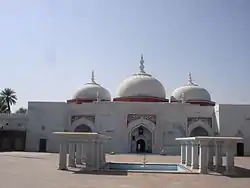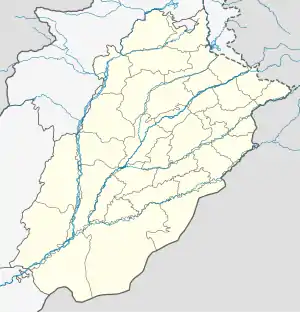Bhera
بھیرا | |
|---|---|
City | |
 Sher Shah Suri Jamia Mosque, 1540 | |
 Bhera Location of Bhera  Bhera Bhera (Pakistan) | |
| Coordinates: 32°28′52″N 72°54′25″E / 32.48111°N 72.90694°E | |
| Country | |
| Province | |
| District | Sargodha |
| Time zone | UTC+5 (PKT) |
Bhera (Punjabi: بھیرا; Urdu: بھیرہ) is a city and a tehsil of Sargodha District, Punjab province of Pakistan.[1] The city is known for wood-carved items, textiles (such as quilts and khussas), and certain desserts (such as pheonian and pateesa).[2]
The city is made up of the Old Town and the surrounding newer development. The Old Town is surrounded by tall walls with eight gates, and is divided up into mohallas, or neighborhoods; historically, different castes lived in different mohallas.[2]
The novel Mayyadas Ki Mari (Mayyadas's Castle), written by Indian playwright Bhisham Singh Sahni, takes place in Bhera.[2]
History
According to Ancient Geography of India by Alexander Cunningham, Bhera was once known as Jobnathnagar.[3]
The Imperial Gazetteer of India records the history of Bhera:
In the seventh and eighth centuries, the Salt Range chieftain was a tributary of Kashmīr. Bhera was sacked by Mahmūd of Ghazni, and again two centuries later by the generals of Chingiz Khān. In 1519 Bābar held it to ransom; and in 1540 Sher Shāh founded a new town, which under Akbar became the headquarters of one of the subdivisions of the Sūbah of Lahore. In the reign of Muhammad Shāh, Rājā Salāmat Rai, a Khukhrain of the Anand tribe, administered Bhera and the surrounding country; while Khushāb was managed by Nawāb Ahmadyār Khān, and the south-eastern tract along the Chenāb formed part of the territories under the charge of Mahārājā Kaura Mal, governor of Multān.[4]
About the same time, by the death of Nawāb Ahmdyār Khan, Khushāb also passed into the hands of Rājā Salāmat Rai. Shortly afterwards Abbās Khān a Khattak who held Pind Dādan Khān, treacherously put the Rājā to death, and seized Bhera. But Abbās Khān was himself thrown into prison as a revenue defaulter, and Fateh Singh, nephew of Salāmat Rai then recovered his uncle's dominions.[4]
In the recent past centuries, Bhera was an important trading outpost on the road to Kabul, and boasted of a taksal (mint) during the rule of Ranjit Singh. The city was known for its knife and cutlery craftsmen, who made fighting daggers (Pesh-kabz) as well as hunting knives and table cutlery, often fitted with handles of serpentine (false jade) or horn.[5] Sir Robert Baden-Powell described the process by which craftsmen manufactured gem-quality serpentine aka false jade from ores obtained from Afghanistan: "The sang-i-yesham (ore) is cut by means of an iron saw, and water mixed with red sand and pounded (with) kurand (corundum). It is polished by application to the san (polishing wheel), wetted with water only, then by being kept wet with water, and rubbed with a piece of wati (smooth pottery fragment), and lastly by rubbing very finely pounded burnt sang-i-yesham on it. This last process must be done very thoroughly."[5]
Attacks on Bhera through history
Bhera has also been attacked by a series of invaders, including:
- Alexander the Great
- Mahmud of Ghazni sacked the city[6] in 1004 CE
- Genghis Khan[6]
- Babar held it for ransom in 1519[6]
- Mirza Muhammad Hakim sacked the city in 1566 C.E.
- Ahmad Shah Durrani attacked in 1757[6]
Bhera in Ferishta's Chronicle
Farishta records[7] that after attacking Ajoodhun, now Pakpattan:
The King marched from thence to another town in the neighbourhood called Dera the inhabitants of which were originally Khukhrain and were banished thither with their families by Afrasiab, for frequent rebellions. Here they had formed themselves into a small independent state and being cut off from intercourse with their neighbours by a belt of mountains nearly impassable, had preserved their ancient custom and rites, by not intermarrying with any other people. The King, having with infinite labour cleared a road for his army over the mountains advanced towards Dera which was well fortified. This place was remarkable for a fine lake of water about one parsang and a half in circumference.
Notable people
- Muhammad Karam Shah al-Azhari, ex-Justice Supreme Court of Pakistan; Islamic scholar[8]
- Amarnath Vidyalankar, renowned Indian politician and social worker
- Balraj Sahni, Bollywood actor and writer
- Birbal Sahni, renowned paleobotanist
- Shanti Swaroop Bhatnagar, eminent scientist
- Ehsan-ul-Haq Piracha, Finance Minister of Pakistan, (1988–1990)
- J.C. Anand, film producer and distributor, founded Eveready Pictures of Pakistan
- Hakeem Noor-ud-Din, first caliph of Ahmadiyya; renowned physician; scholar of Arabic and Hebrew
- Maulvi Sher Ali, Ahmadi missionary, known for his English translations of the Quran
- Bashir A. Tahir, a prominent international banker
- Neelo, Pakistani film actress
- Sikandar Sultan Raja, Chief Election Commissioner of Pakistan in 2023
- Sheikh Inam ul Haq Piracha, Ex District Governor (Nazim) and MNA National Assembly of Pakistan[9]
- Pir Muhammad Amin Ul Hasnat Shah, Pakistani politician from Bhera who served as Minister of State for Religious Affairs and Interfaith Harmony (2017 - 2018)[10]
Historical places in the vicinity
- Tilla Jogian
- Salt Range
- Midh pargana miani
References
- ↑ "Tehsils and Unions in the District of Sargodha (see Bhera listed under Bhalwal Tehsil)". National Reconstruction Bureau, Government of Pakistan website. Archived from the original on 9 February 2012. Retrieved 5 June 2023.
- 1 2 3 Khan, Omar Mukhtar (9 July 2019). "Bhera: Town on the river". Dawn (newspaper). Archived from the original on 8 July 2019. Retrieved 5 June 2023.
- ↑ Ancient Geography of India, page 130 – Alexander Cunningham
- 1 2 Imperial Gazetteer of India v22 page 214
- 1 2 Watt, Sir George, The Commercial Products of India, London: John Murray Publishers (1908), p. 561
- 1 2 3 4 History of Bhera on Imperial Gazetteer of India v2 page 213
- ↑ Farishta Vo1 Page 80 Translation by John Briggs
- ↑ Some new faces in Sargodha Dawn (newspaper), Published 26 August 2002, Retrieved 5 June 2023
- ↑ "Pirachas again go for NA-64: A test of voters' memory". Dawn (newspaper). 16 November 2005. Retrieved 5 June 2023.
- ↑ "Ulema and Mushaikh Council formed to promote inter faith harmony: Minister of Religious affairs". Pakistan Today (newspaper). 25 November 2016. Archived from the original on 22 February 2017. Retrieved 5 June 2023.
